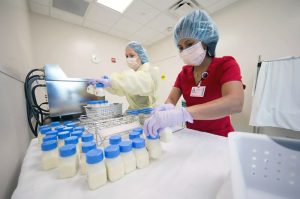
I'm a planner, and my plan was to have a completely natural birth and to breast feed only. This plan was written in stone (or so I thought). Long story short – my birthing plan flew out the window. One of my complications was very high blood pressure, which refused to go down even after birth. Due to the stress of the delivery (and other unknowns), my baby never latched. She would scream and cry, staying hungry and not gaining weight. My heart was breaking.
While still at the hospital, the lactation consultant suggested supplementing with donor breast milk. Once we started using the donor breast milk, our baby quickly gained weight. When we brought our sunshine home, I started pumping myself. I pumped about seven times a day – even when I got back to my full-time job at SAS.
This is when I began learning about the amazing moms who donate breast milk. I pictured them tirelessly pumping their precious breast milk – all so that my baby (a baby they will never know) and other babies in need can thrive. To this day, I get teary when I think of what they do to help others.
I wanted to know more about the organization that makes it all possible: WakeMed Mothers' Milk Bank. It's a non-profit milk bank that provides 200,000 ounces of safe, pasteurized donor breast milk a year to babies in birthing centers, NICUs, and hospitals in North Carolina and all along the east coast.
Applying data and analytics to help non-profits
Merging my passion for mathematical optimization, Data4Good and teaching, I found the perfect match: I would have my industrial systems and engineering students at North Carolina State University develop data analytics projects for local non-profits. Obviously, the first organization that came to my mind was the Mothers' Milk Bank. I reached out to their director, Montana Wagner-Gillespie (a 2013 NC State graduate herself), and we discussed challenges that could be approached through data analytics.
“Natalia and the students offered a lot of avenues for research I hadn’t even thought about,” Montana said. “I started thinking about some of our problems and growth initiatives. The milk bank runs with a very small staff, and we're unable to really deep dive in our data and draw conclusions from it."
Using data and optimization to find a better way
We agreed to have one student team focus on finding better ways to gather milk from the donors. Though the milk bank offered a few drop-off locations, much of the milk was shipped and the process was complicated and very expensive.
Montana hypothesized that opening new drop-off locations might be the right strategy. We wanted to validate that the initial set-up costs (such as equipment investment and personnel training) didn't outweigh shipping savings. We also needed to determine the best new drop-off locations.
Thousands in savings
The student team — Jennifer Breese, Diego Hernandez, Sean Murray, Drew Schell, and Conner Walker — developed a facility location mathematical model to determine the potential benefit of more drop-off locations. The model used data collected by the milk bank, including donation history, donor location (zip codes) and delivery method (shipped, dropped-off, etc.).
With the use of SAS/OR, specifically PROC OPTMODEL and the MILP solver, the team determined that the milk bank could open as many as 15 more drop-off locations and save more than $10,000 by doing so.

“The students' findings suggested we can absolutely justify the up-front costs. Having extra depots can save us thousands and thousands of dollars each year in costs, and we’re in the process of executing that plan now. It was so well-researched and clearly quantified that our hospital administrator could easily see the initial investment was a justifiable cost due to the high shipping cost savings,” Montana said.
After the students presented their analysis, six new drop-off depots were opened at other WakeMed health system sites and more are planned statewide -- saving on shipping and increasing the milk bank’s community presence to drive donations. It was a win-win for all involved.
If you're interested, please learn more about the WakeMed Mothers’ Milk Bank or milk banks around the globe.
____________________________________________________________________________________
Editor's note: We're sharing this personal and professional experience in celebration of International Women’s Day, and SAS' hope that stories of women innovating in AI is an inspiration to others. Use the hashtag #EachForEqual when sharing this post to join us!


3 Comments
It's amazing all the different ways and places that SAS analytics and data scientists can have an impact!
Thank you Mike!
This is such great dedication and work! Thank you for sharing!